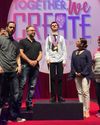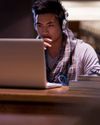
Spanish novelist Carlos Ruiz Zafón wrote that “destiny doesn’t make house calls; you have to go for it.” Going for it is a great way to describe Linda Brown, a veteran computer science and information technology teacher in Washington County School District (WCSD) in St. George, Utah. Throughout a 24year teaching career she has definitely gone for it.
It was during her senior year at Box Elder High School in Brigham City, Utah, when destiny knocked — or, to be more precise, threw a users’ manual her way. Brown was spending part of her days as a teacher’s aide in the business department when the school purchased its first computers.
At the time, Brown was also known as an extremely quick typist, tapping out a blazing 103 words per minute. (The average teenage student clocks in between 37 and 40 WPM today.) She even won the statewide Future Business Leaders of America (FBLA) typing competition that year.
Back then, having computers in school was not a common occurrence. Most staffdidn’t have much of an idea about how to operate them, nor did they have the time to learn. Acknowledging her dependability, willingness to learn, and certainly her typing speed, the department head tossed Brown the users’ manual and told her to see what she could do.
“There were six computers, along with a bunch of those old 5.25-inch floppy disks,” Brown recalled, “and I had to read the book to figure out how to set them up and then use them.”
Jumping into the world of computers
This story is from the October 2020 edition of Certification Magazine.
Start your 7-day Magzter GOLD free trial to access thousands of curated premium stories, and 9,000+ magazines and newspapers.
Already a subscriber ? Sign In
This story is from the October 2020 edition of Certification Magazine.
Start your 7-day Magzter GOLD free trial to access thousands of curated premium stories, and 9,000+ magazines and newspapers.
Already a subscriber? Sign In

Wanted: Your Cloud Computing Skills
Employers need cloud computing expertise, but demand is outstripping supply

The Job Before Your First Job
An IT internship can be your strong first step toward a rewarding professional career

Professionalizing the CLOUD
A conversation with the exam architect behind the hottest certification in cloud security

SETTING HIS SIGHTS ON SUCCESS
Ohio IT student has mastered computer repair, cybersecurity, and certification

The Typist Who Became a Technologist
Long time Utah IT educator got her first exposure to computers in high school

Pick a Cloud, Any Cloud
Which cloud computing models best support business aims — and which ones should you learn?

Here, There, and Everywhere
Distributed cloud computing is bringing the cloud closer to all of us

Master of Efficiency
A skilled operations analyst fine tunes processes to help organizations flourish

Learn Smarter, Not Harder
Everyone is doing online learning now — but that doesn’t mean they’re doing it right

From Horizon to Horizon
No matter where you look, cloud technology is blanketing the IT industry